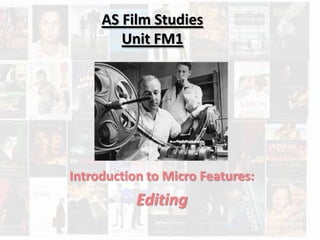
EDITING
- 1. AS Film Studies Unit FM1 Introduction to Micro Features: Editing
- 2. Lesson Aims By the end of the lesson you will be able to: • Understand and apply editing terminology • Deconstruct how editing is used to communicate meaning
- 3. Definition: Editing • Editing a film involves selecting and combining shots into sequences • Good editing is a critical element in getting the audience to understand the film’s story, by creating or enhancing mood, emotion and character. • The director needs to create enough shots for the editor to choose from to tell the story.
- 4. Montage • A montage is created through an assembly of quick cuts, disconnected time or place, that combine to form a larger idea. A montage is frequently used to convey passage of time, coming of age, or emotional transition
- 5. Parallel Editing • This occurs when two scenes are shot in sequence, but presented by cutting back and forth between them. This creates a sense of two actions occurring simultaneously in two different locations
- 6. Split Screen • A split screen runs two shots side-by-side within a single frame. Like parallel editing, a split screen create the idea of simultaneous action. • Split screen was a staple of the 1950s and 1960s
- 7. Dissolves • Dissolves blend one shot into another. This achieved optically by fading out the first shot while the second shot fades up. A dissolve softens a cut. Dissolves can be brief or extended depending • they are often used to how ‘soft’ the film show the passage of maker wants the effect time – this is referred to to be as ELLIPTICAL EDITING
- 8. Expanding Time – Overlapping Action • This ads dramatic value to a scene. It can shine a light on a particular moment or an entre • Suspense is evoked by scene. It is often used milking the scene with to underscore the clever use of important plot twists, cutaways and reaction climatic scenes, and shots. In this way time pivotal emotional can be stopped by revelations extending the time it takes for the moment to play out on screen
- 9. Graphic Match • Graphic matching is when a scene links to another scene using the same shape or colour – this can occur with the use of a cut or a dissolve
- 10. Visual Match Cut (Idea) • A cut on idea is when two shots are cut together and by their juxtaposition, a third idea is suggested. This new ides is the sum of the first two
- 11. Fast Motion (Time Compression) • Fast Motion compresses reality, this technique is used for those scene that need to be especially heightened • Slowing down reality is often used to show how a character sees the world when in the midst of a traumatic event
- 12. Rhythm & Pace • Editing sets the rhythm or pace of a scene. This could be dictated by either the music used behind a scene or the mood that the editor is trying to create and the pace that you edit. To build up tension in a scene you might cut from one shot to another very quickly. However, in a relaxed scene the editing will progress at a much slower pace, dwelling longer on each shot.
- 13. Long Take
- 14. Jump Cuts, Match Cut, Cut Away
- 15. Editing is something of an ‘invisible art’, because we Continuity Editing rarely notice the cut between one shot and another. • Despite all this art and • Shot reverse shot craft, the audience hardly • 180 degree rule ever notices good editing. • Although we know that we • Match on action are watching pieces of film • Straight Cut joined together, we are so used to continuity editing that we accept what is • The use of continuity happening on screen editing makes action on providing that it follows the screen ‘appear’ to the rules that we have be seamless learnt through watching other films or narratives.
Hinweis der Redaktion
- Here themonatge suggests passge of time and charctersprogressio. By using the same construction twice, it allows the audience to make comparisons and from that ne inferences
- Kill Bill – suggests the immentphyiscal proximity of the vitim to the assassin by having the two share the frame. We see what appears to be leathal hypodermics needle alamost touching the arm of the sleeping victim (Black Mamba) where the assassin intends to emtpy it. In this way the writer/director Tarantino exploits the elasticity of time and place that the split screen provides and is able to heighten the suspense of the scene
- Dissolves link two idea together by blending one image in to another. In thiscasemutiple views of the esate are presented but remain connected by the use of dissolves, they are often used to show the passage of time
- Time is completely slowed down in such way that it’s as though each shot is a breath. The audience absorbs the rhytmn of the editing; breathing with Vincent, his anxiety becomes ours, as we watch Vincent prepare to plunge the needles into Mia’s chest
- The cut suggested that Sara and Tyrone are untied by drugs, each in their own prison. We subconsciously apply the jail jars to both characters. We derive the new meaning from the ideas suggested by the juxtaposition
- Fast motion used to convey the shoddy treatment that Sara receives from doctor – speeded up action underscores the doctor’s inattention and the inevitability of Sara’s descent